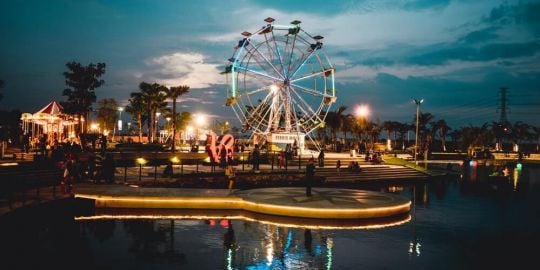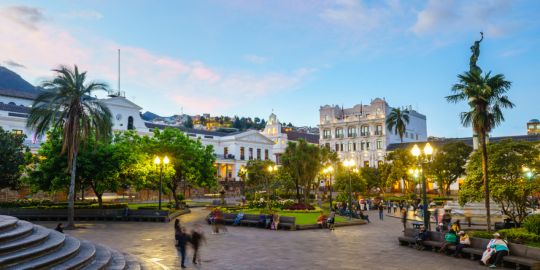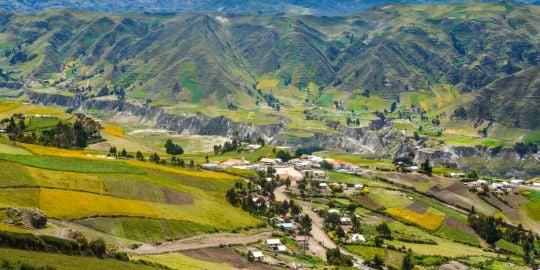Rescuers pull a 72 year old man from rubble alive after 13 days.
http://www.dailymail.co.uk/news/article … quake.html
Powerful 7.8 Earthquake Rocks Ecuador’s Coast -- Hundreds Are Dead
Thank you, Russell.
I PM'd Fall off the Map to see if he would forward me the removed video links.
I watched all three of the links and they are exactly as advertised, on-the-ground video of earthquake damage and relief. Less than 2 minutes each.
There is no legitimate reason these videos should not be reinstated for other members to view.
Expat.com should rightfully return the posted links to Fall off the Map's post.
High-rise condo apartments were a big seller in recent years in Bahía de Caráquez. Security and ocean views attracted buyers from Colombia, Venezuela and North America.
In Bahía there are about 70 condo buildings of six to ten floors. These buildings did not collapse in the April 16th earthquake.
Now, however, comes word that there are indications of serious structural damage to these condos.
The Cuenca Highlife website quotes retired architect Pablo Salazar:
“Large areas of the walls have fallen away and there are large cracks running from top to bottom in some cases.... Window and door frames have been twisted and probably cannot be repaired.”
Dozens of condo buildings in Bahía, Manta and Pedernales have been taped off. Only emergency personnel -- and not owners -- have access while the municipalities concentrate on clearing rubble from non-condo buildings.
Eventually, real estate and insurance interests will have to be settled -- possibly in Ecuador's court system.
source: www.cuencahighlife.com
cccmedia in Quito
gardener1 wrote:I PM'd Fall off the Map to see if he would forward me the removed video links.
I watched all three of the links and they are exactly as advertised, on-the-ground video of earthquake damage and relief. Less than 2 minutes each.
There is no legitimate reason these videos should not be reinstated for other members to view.
www.youtube.com/watch?v=xRCozvzpIB8www.youtube.com/watch?v=WTxgLS0X0ygwww.youtube.com/watch?v=ICHPFy0Sz4s
May 18, 2016:
32 days after the big earthquake centered in Esmeraldas province rocked the EC coast, killing 650 and injuring thousands, two powerful earthquakes of magnitude 6.7 and 6.8 occurred in the same province today.
At least one of the newest quakes was centered 14 to 21 miles NW of Rosa Zarate (distance depending on the report), a small village in the northwestern-Ecuador province.
Dozens of aftershocks were also reported today.
We have not seen reports of casualties or destruction yet in Esmeraldas province or nearby areas.
Sources: www.earthquaketrack.com and dayinquito.blogspot.com
As far away as Quito, about 100 miles away, we experienced momentary shaking in residences at 2:57 a.m., the time of today's first quake.
A late report puts the magnitude of one of today's quakes even higher, at 7.2. (independent.co.uk)
-- cccmedia in Quito
We heard the news in the US about another quake there in Ecuador. There was snow in the desert of UAE where it's usually 120 Fahrenheit. Can you imagine? Oman has had torrential downpours and now insufferable heat. We (in VA) usually don shorts and t-shirts in May but it's been unpredictably cold and rainy here for weeks on end, having to wear coats and sweaters. Mother Nature is wreaking havoc all around. Be well.
The second of today's powerful earthquakes in Ecuador occurred near the small coastal town of Mompiche. (New York Times) That quake occurred at 11:46 a.m.
Power outages are reported in Esmeraldas province and Manabí province. (Reuters, based on witnesses)
El Presidente tweeted that schools closed today in those two provinces.
cccmedia in Quito
Some video footage of what looks like the inside of an office building. Place is shaking, and swaying like crazy. Has to be scary as hell.
https://www.youtube.com/watch?v=OU8glc_SI-0
These latest earthquakes are blamed for one death -- an elderly woman -- and 120 injuries in the area around the epicenters.
Here in Quito, two people were injured when a crowd trampled them while running out of a building during the midday quake.
Risk management reports that some buildings in coastal areas that were damaged in the April 16th quake collapsed or sustained more severe damage in the May 18th quakes. In Esmeraldas, some buildings not affected in April sustained irreparable damage in this week's after-quakes.
Source: www.cuencahighlife.com
cccmedia in Quito
Five weeks after the April 16th earthquake, the insurance sector has paid 486 quake-related claims, paying out about $14,095,000.
Close to 13-thousand quake claims have been submitted, so that means about four percent of claimants have been paid. Most of the paid claims are from coastal areas from Esmeraldas to Guayaquil.
Since a government estimate of quake damage is in the billions, it's evident that only a tiny percentage of the damage has been compensated by insurance so far.
source: www.cuencahighlife.com
-- cccmedia in Quito
July 6, 2016, update....
Two-and-a-half months after the devastating earthquake hit the Ecuadorian coastal areas, a series of more than three dozen earthquakes up to magnitude 4.9 shook coastal Esmeraldas and Manabí Provinces early on Wednesday morning of this week -- causing schools to close and sending residents into the streets and parks through the overnight hours.
The quakes are considered aftershocks from the April 16th monster quake of 7.8 magnitude, according to Ecuador's Geophysical Institute.
No serious injuries or major damage has been reported in early assessments of these aftershock quakes.
The fresh quakes were centered about 60 kilometers or 35 miles north of the April 16th event.
They occurred between 1 and 7 in the morning, and by the time it was considered evident that they had stopped coming, many Esmeraldas-area schools had been closed for the day.
source: www.cuencahighlife.com
-- cccmedia
A 5.5 magnitude earthquake(aftershock?) occurred at Bahia de Caraquez about 30 minutes ago.
A lot of activity lately, hopefully the faults are readjusting to their normal positions.
Instituto Geofísico @IGecuador 29m29 minutes ago
#SISMO ID: igepn2016nhqy Rev. 2016/07/07-23:28:40 TL Mag:5.5 Prof 5.74 km, 75.66km Bahia de Caraquez,Manabi
Just endured back to back strong quakes 6.5 and 6.6 in a 10 minute span. People in streets in Quito.
#SISMO ID: igepn2016nmyn Prelim. 2016/07/10-21:01:10 TL Mag:6.5 Prof 10.00 km, 24.81km Muisne,Esmeraldas
They downgrade the second one to 6.2, which I don't understand because it was stronger, and shook chandeliers and wall mirror, more so than the 1st.
I think USGS got it right, 5.9 and 6.4 because 2nd was stronger.
The two earthquakes/aftershocks of late Sunday night (July 10, 2016) occurred ten minutes apart, with the epicenter(s) about 25.5 miles or 41 kilometers south of coastal Esmeraldas city.
“Slight shaking” was felt in Quito, about 94 miles from there, according to ABC News's report based on information from the Ecuador Geophysical Institute.
There were no immediate reports of casualties or damage.
Source: ABC News at 11:14 p.m. Eastern Time (July 10)
Can somebody recommend the bare minimum (note: the bare minimum) list of items to have to hand in the event of an emergency escape from a city building during an earthquake? There is no consensus, and Ecuadorian advice includes just about everything apart from the kitchen sink.
Bare minimum? Drinking water, emergency food and money. The more of each the better. Oh, and maybe a tarp to keep out of the rain, and a light sleeping bag.
I'd be inclined to take more than the bare minimum, though. You can find many recommendations on-line for what to put in a "bug-out bag".
https://www.ready.gov/kithttp://www.treehugger.com/culture/decon … looks.htmlhttp://www.popularmechanics.com/technol … to-go-bag/
We have a bag with our passports, atm cards. We live on high floor in a high rise so it's many flights of stairs down, and carrying minimum is best. We'll only evacuate if I feel structure is compromised, otherwise under dining room table is safest for us. Thankfully the dining room table is located in the safest part of the building with bigger column support.
If however we (Quito) receive our own earthquake I don't think we'll have time or stability to be able to walk to dining room table if we're sleeping. My concern now and I'm not sure if it's founded but what is the effect of continuous 6+ magnitude aftershocks on the structure of non-earthquake resistance buildings? I know that a study of Mexico city's last big earthquakes found that buildings that were 3 stories or less were more vulnerable to collapse than taller buildings, but I find no consolation in that.
vsimple wrote:I know that a study of Mexico city's last big earthquakes found that buildings that were 3 stories or less were more vulnerable to collapse than taller buildings, but I find no consolation in that.
Interesting thought. It is possible that the high-rise would be as safe or safer than a three-story building - all depends on design and construction. Certainly the design and construction standards for a high-rise would be stricter than what would be prescribed for a much smaller structures. Finding out the design and construction for a particular building more than a couple of years old might be difficult.
SawMan wrote:Finding out the design and construction for a particular building more than a couple of years old might be difficult.
It might be difficult, but Expats still considering the EC coast and other Ring of Fire areas need to make such discovery an essential part of their due diligence regardless of the age of the building.
Expect to see developers and real-estate professionals begin advertising building safety in new construction and re-construction at the coast, once new/rebuilt residential structures are ready for prime time.
cccmedia
Most towns and cities near the Ecuadorian coast that were rocked by the April 16th monster earthquake are rebuilding.
Not Muisne (MWEEZ-nay), though. After more earthquakes hit the local area a few days ago, El Presidente has now decided to move the residents of Muisne to a spot further inland and away from the epicenters of the quakes that largely destroyed the place. Muisne is also vulnerable to potential tsunamis and thus a strong candidate for relocation.
The town had a population of about 6,000 as of the 2010 census.
Government money will be used to fund the relocation of the former population of Muisne.
Still to be decided is how the residents will be compensated for the loss of their property, which will be off-limits to re-building by presidential decree.
Residents of some smaller places, including Portete, were recently moved elsewhere as well, following the April earthquake.
Source: www.cuencahighlife.com
-- cccmedia
A strong 4.6 magnitude earthquake hit Quito about an hour ago. Strong enough that it violently shook paintings and felt like it lifted the building. It appears to be from the same area as the last one, Puembo, and there are reports of a few injuries and minor collapse of a part of a church.
http://www.elcomercio.com/actualidad/fu … quito.html
The USGS reports that it was a 4.7 with an epic-center in Sangolqui, which is just 12-15 km south of north-centro Quito.
The USGS and IG apparently conflict on the location of the quake with one reporting Puembo and the other Sangolqui. Could be it's one fault passing passing through both locations?
For folks living in Quito here is an interesting read. It's a 45 page PDF and details what would happen in a hypothetical situation of three separate earthquakes occurring with varying magnitudes and distances from Quito. It includes various maps that illustrate the extent of the shaking and damage in different sectors of the capital.
http://horizon.documentation.ird.fr/exl … 006840.pdf
Thanks vsimple, I read the report with interest. Russell
That is scary. I pray that there are no big afterschocks. I hope people were safe in ttheur homes. It seemed from your post that it happened about 3 am. I'm going to check the news here for more information.
russelleaton wrote:Thanks vsimple, I read the report with interest. Russell
You're welcome. There's good information there, and it's summed up that possible or in their case eventual devastation will be determined by 1.) Magnitude of Earthquake 2.) Distance from the Epic-Center, and 3.) Soil condition.
I liked it because it is brings awareness to Earthquakes in Quito. We can't control the magnitude or distance of the earthquakes but we can control the type of residence we live in, and re-enforced concrete residential dwellings will offer good protection.
Checking the earthquake report on the
http://www.igepn.edu.ec/portal/ultimo-s … sismo.html
is still something I do a few times a day...
But now I sleep through the night, without my clothes on and my hand on my napsack.
Montañita was very blessed not to be affected by the earthquake directly, and doubly blessed that the tide was out and the moon was neither at full nor new, so we did not have a tsunami, which would have wiped out the coast and increased the loss of lfe to probably 8 to 10,000 easily.
Good friends of mine in Canoa are still iving under plastic ---their home destroyed and their car totalled under falling brick. Neighbors lost family members. Their first contact was the army coming through asking how many body bags they would need.
These are folks in animal rescue and have been doing what they can along with others over thepast 4 months rehome abandoned animals, humanely euthanize those who cannot be saved, get food to the areas hit and of course water, vaccines, etc. And this includes not just dogs and cats but horses (and burying a horse is no simple matter)
The repicas (repeated tremors) are still occurring though most are under 4.5 The latest was just a few hours ago off the coast of Manabi and 3.5M.
i am awed and humbled by the manner in which the people of Ecuador endured this catastrophe. I cannot imagine this occurring in the "first world" and having an outcome as optimistic as things are here.
Good friends, writers, builders, artisans, responders, construction workers, surfers, yoga instructors, teachers, and the Saras (two amazing women with backgrounds helping in catstrophes) have been especially instrumental in the area of Canoa The SAMAN project at Rio Canoa and in the controlled demoloition of damaged buildings in and around Canoa. And people are beginning to get their lives back.
Do come visit Ecuador. Visit the coast --- Manta north through Esmeraldas was effected but the rest of the coast is ready to welcome you. And visit the coastal areas of the towns hit, their tourist infrastructure needs your visit to help support the families there too. Many families live spread out over the entire coast, so a visit anywhere helps everywhere!
If you want more information ...just message me and I would be happy to help!
Susan
Great comments Susan. Ecuador is a fantastic country, and perfectly safe from earthquakes if you take normal precautions and use your common sense. Compared to other South american countries, Ecuador has a low crime rate and is safer than many other 'developed' countries.
Actually Russell, I have to disagree.
No place is "perfectly safe" in the rim of fire, the Pacific circle of earthquake prone areas. YOu move to Ecuador you MUST take the possibility of an earthquake into account, and tsunami on the coast. To think otherwise is simply sugar coating reality. And as we all know... only real estate agents can get away with that one!
Just as the Caribbean and Florida, Gulf coast and Eastern Seaboard have Hurricanes, and Tornadoe Alley of the Midwest has cyclones, and the West coast has its faults, Ecuador and the entire Pacific coast of South America, just like Central and North America, will always have earthquakes.
Your precautions are also limited as you never truly know the safety of the building you are in. There was little monitoring of construction, thogh hopefully thatis changing now, but does not cover construction prior to April 2016.
When an earthquake hits, it is completely in the hands of G-d, fate, and karma if it will hit your area. And just plain luck if you are hit that you will be one of the ones who gets out before the building drops.
I am sorry to sound like the voice of doom but this was a real disaster, and I could graphically describe the site, sound and smell of it if that is what is required for anyone to take this seriously.
It took most of us here on the coast where I am, 2 hours south of the start of the zone of catastrophe, months to sleep through the night. Sounds took a whole new meaning, like a dog barking for no reason, a rolladen shutter being dropped, heavy machinery on the road, and of course the larger tremors.
Ecuador had a disaster almost 5 months ago. Italy had one just a week ago. Ecuador had one as bad in 1997 (Bahia) and in the 40´s and the 20´s. They do occur.
russelleaton wrote:Great comments Susan. Ecuador is a fantastic country, and perfectly safe from earthquakes if you take normal precautions and use your common sense. Compared to other South american countries, Ecuador has a low crime rate and is safer than many other 'developed' countries.
Where are we perfectly safe in Quito? There are active faults along the eastern basin of Quito. There are faults in the south and northeast. We, residents in Quito, are vulnerable as the news media pointed out because we are in close proximity to active faults and are close to areas of previous earthquakes, of which some were quite devastating.
You stated you read the report I posted, and I have no idea how you can conclude we are in any way safe. There are many factors to determine a probability of “safeness” that I don't want to even get into, but there are factors such as oscillation, resonance, building quality, soil condition, etc, but even with that there are factors we cannot even predict such as magnitude or distance from the epic center, and if our own residence is best suited for the shaking of that particular quake.
My guess in terms of safeness is central Quito, it's away from previous earthquakes of Guayllamba (north), and Southern quakes(Sangolqui & Tambillo) and of course more recent eastern quakes at Puembo. That and housing with reinforced concrete is our best probability and of course being perpendicular to fault lines as one study concluded.
vsimple wrote:Where are we perfectly safe in Quito? There are active faults along the eastern basin of Quito. There are faults in the south and northeast. We, residents in Quito, are vulnerable as the news media pointed out because we are in close proximity to active faults and are close to areas of previous earthquakes, of which some were quite devastating.
Quito has actually had some pretty devastating earthquakes in the past.
http://www.history.com/this-day-in-hist … to-ecuador
Granted, it's not a yearly occurrence, and probably shouldn't be a major deciding factor preventing anyone from moving to Quito, but does remind you that pretty terrible natural disasters can occur at any time.
j600rr wrote:vsimple wrote:Where are we perfectly safe in Quito? There are active faults along the eastern basin of Quito. There are faults in the south and northeast. We, residents in Quito, are vulnerable as the news media pointed out because we are in close proximity to active faults and are close to areas of previous earthquakes, of which some were quite devastating.
Quito has actually had some pretty devastating earthquakes in the past.
http://www.history.com/this-day-in-hist … to-ecuador
Granted, it's not a yearly occurrence, and probably shouldn't be a major deciding factor preventing anyone from moving to Quito, but does remind you that pretty terrible natural disasters can occur at any time.
Well for us these latest earthquakes have definitely altered our plans. We've always maintained a residence in our home country so we have that option, but I am in the process of registering our homeschool with our school district so the kids will be returning. One will begin college next fall so that's an easy decision and the younger one who has two years left will do community college courses as part of our homeschool curriculum which is a good thing.
When the big 7.6 hit, I thought okay it's the coast and probability wise another big one won't occur for a long time. But when we had the 4.6 and 4.7 in a span of less than a month with an epic center that is 13km from where we live, It made me re-evaluate our situation. I am willing to take the risk, but my kids are too young to make that decision and I've decided they're leaving.
Do you live in Quito or the coast and with kids? As a father who is probability minded and who looks at a whole lot of data, there is nothing reassuring about what we experienced in Ecuador this year with regards to earthquakes. Just south of Ecuadorean border in Peru, a 6 magnitude earth struck this week. Our building has shook and swayed about 10 times since April with earthquakes and aftershocks. And some of them were quite violent, especially the P waves of Quito's quakes.
Heads up people. I have seen an earthquake resistant building being constructed. They had a banner in front with "sistema de construcción de ultima tecnologia", and after further inquiry I found out it is earthquake resistance up to a 8 Magnitude earthquake.
I am not sure if they have isolation bearings but I presume so. I noticed immediately that it was unique because despite the construction being limited to 3 stories the materials were more indicative of a high rise. BTW this was in Tenis.
Hopefully this trend continues.
vsimple wrote:I noticed immediately that it was unique because despite the construction being limited to 3 stories the materials were more indicative of a high rise. BTW this was in Tenis.
For the out-of-towners, Tenis is an upper-class residential sector in north Quito.
The fact that this building is three stories high is another aspect that bodes well for its earthquake-‘proofness.'
The higher the building, the more vulnerable it is in case of seismic trouble.
cccmedia
Hi Everyone, here is an interesting article on Ecuador in light of the recent earthquake.
abecuador.com/single-post/2016/04/20/Considering-Options-in-Light-of-the-Recent-Earthquake
I hope is helpfull for you.
mountain aire wrote:Pascal Laflamme from the project Las Olas has lost his wife and his 12 years old son...this is very SAD
Thank you very much for your message, very appreciated.
Pascal









